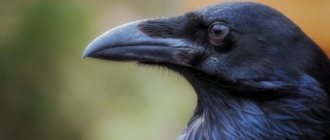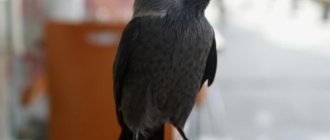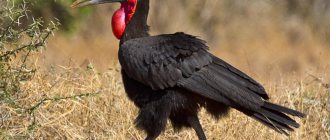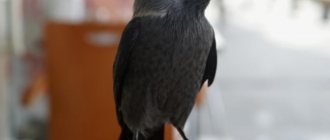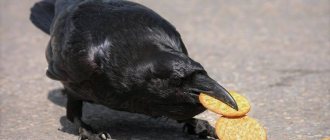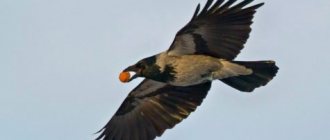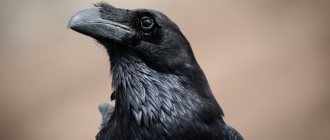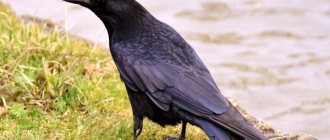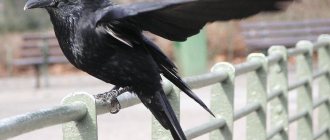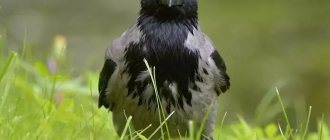Appearance
— Advertising —
Raven is a representative bird. It looks impressive due to its massive sharp beak, long legs, and large eyes. Wing color is black. The Raven cannot be confused with other similar birds from the Raven genus - it is distinguished by long narrow wings, as well as a densely feathered wedge-shaped tail.
Adult ravens have black, glossy feathers, with a bluish tint on the upper part of the body and a greenish tint on the lower part. The feathers of young animals are matte black. The beak and legs of ravens are also black. You can tell which bird is in front of you - a female or a male - by its size.
— Advertising —
Males are larger in size than females. The physique of male representatives is dense and compact. The feathers are glossy, tightly pressed to the body. The neck is thick and large.
The weight of females ranges from 800-1200 grams. Their tail is not so long, their neck is thin.
You can distinguish ravens from rooks or ordinary crows by their black beard of thin feathers. They shake while singing.
The smallest crow lives in Mexico
If the average adult corvid weighs approximately 500-600 g, then the smallest representative of the family weighs only 41 g. This is the dwarf Mexican jay (Aphelocoma nana). It is also called the Lesser Variegated Jay. It lives endemicly in the southern part of the North American continent. Its natural home is tropical and subtropical mountain forests. Due to the systematic destruction of its habitat, the Mexican pygmy jay has received the protection status of the biological taxon "Vulnerable Species". If the situation with deforestation does not change, then this animal may become an endangered species.
Lifespan
In the wild, crows live 13-15 years. The life expectancy of nomadic species is reduced to 10-12 years. When kept at home, crows can live up to 40 and even 50 years. There have been cases when a feathered pet lived to be 70 years old. If the raven's conditions are incorrect, it will live much shorter.
An unbalanced diet can lead to obesity or rickets. The bird quickly dies from its painful condition.
Nutrition
Raven is an omnivorous bird. Forest birds feed on insects, snakes, fish, rodents, lizards, frogs, small birds and their chicks. Ravens are also called scavengers because they do not hesitate to feed on dead animals and food waste. City crows circle in flocks over garbage dumps in search of food. However, they are only interested in fresh food; if the food is spoiled, the bird will not touch it.
The diet contains food of plant origin. Crows happily eat grains and fruit crops. In the gardens they feed on cherries, currants, strawberries, and grapes.
The raven, like any other bird of prey, hunts mainly during the day. The hunting territory is several square kilometers. Raven performs all actions deliberately; risk is not in his nature. While looking out for prey, it can sit in ambush for up to 15 minutes. The raven, having caught its prey, shares a meal with its relatives. It doesn’t matter what size the prey is. The main thing is that the family is fed. Crows bury leftover food to eat later. According to the observations of ornithologists, burying and digging up food and various objects is a favorite pastime of these birds.
Spreading
Area
Numerous populations of ravens live in the northern latitudes of Eurasia (with the exception of the islands of the Arctic Ocean, the Yamal, Taimyr and Gydansky peninsulas), in Greenland, North America, and North Africa. It is poorly represented in tropical latitudes. There are small settlements of ravens in the mountainous regions of Syria, Iraq, Iran and Pakistan, China, and northern India. It does not nest in Kazakhstan and the deserts of Central Asia. It is rare in European countries.
Habitats
Crows nest on Arctic coasts, tundra and desert. In the northern regions, they settle on rocky shores and in vegetation along rivers. In mid-latitudes they prefer broad-leaved and coniferous forests. They settle near ponds and swamps. In the taiga they live on the outskirts of forests. In the south, crows settle in hilly areas, in floodplain forests. In search of food, they settle near human habitation. They nest in suburbs and villages.
Habitat - where it lives
Habitat of the raven
The raven lives in all countries of the Northern Hemisphere. It is found in Europe, Asia, North America, and also in North Africa. The bird can settle in the following places:
- mountains;
- deserts;
- sea coasts;
- dense forest - most often found here, especially if the forest is spruce;
- parks and squares (most common).
Lifestyle
It is known that crows are smart, cautious birds. They can brilliantly maneuver in the air and walk on the ground. Before taking off, the raven makes several short jumps, and then rises upward with one flap of its wing. In flight, a raven resembles an eagle rather than a bird of the corvid family. The wing beat is rare, with a large amplitude. These birds are one of the few birds that can perform figures similar to aerobatics - “barrel and half-roll”. In flight, the wings make a peculiar sound, similar to a ringing sound.
Crows lead complex social lives. They learn throughout their lives and easily adapt to changes in environmental conditions. In early spring, they create permanent pairs, build nests together, and raise offspring. They settle at a distant distance from each other (no closer than 1 kilometer from each other). During wintering, the pairs separate. Birds can winter with other bird species.
Crows yearn for their dead relatives and organize peculiar farewell ceremonies for them. First, the flock circles over the dead comrade for a long time, and then they sit on tree branches and remain mournfully silent.
Intelligence and acumen
If you watch a family of ravens, you will see that the birds communicate using gestures. An individual who wants to attract attention clamps a twig or leaf in its beak and demonstratively shows the “toy” to others. Sometimes birds play a game, the meaning of which is to alternately raise and lower a pebble, holding it in its beak. The game continues until one of the players drops it. Crows use technological progress to obtain food: they throw nuts under the wheels of cars to crush them. In winter, birds ride down snow slides.
Clever crows demonstrate their intelligence by throwing nuts under the wheels of a car to crush them.
The fact that crows have fantastic intellectual abilities is evidenced by the results of experiments by scientists around the world. For example, if you put two bowls of food in front of a raven, he will choose the one with more food. They like to soak dry bread crusts in water before eating.
Reproduction
Birds reach sexual maturity at two years. The mating season passes calmly and quickly. Forest birds choose tall trees to build their nests. The dwelling is built at a height of at least 15 meters. Crows living in desert areas settle on rocks. Both the female and the male are busy organizing the home. The raven's nest is a voluminous, spacious, bowl-shaped structure. When building a house, birds use twigs, wires, and laces, which are skillfully intertwined. Sometimes the building is made of one material.
Laying occurs early - in February-early March. The reason for this is the melting of the snow cover, when dead animals thaw and food appears. The female lays up to 6 eggs, colored dirty blue with brown spots on the surface. Egg sizes: 4-6 centimeters long, 3-3.8 centimeters wide. Laying continues for a week. The incubation process begins after the third egg is laid. The female does the incubation, while the male carries food to her.
After three weeks, the chicks begin to appear. The hatching process takes two days. The head and back of newborn chicks are covered with thick dark brown down. For the first two weeks, the female warms the young, while the male feeds both the female and the chicks. Then the mother flies out of the nest, and both parents are engaged in feeding. The chicks eat the same food as their parents - insects, pieces of raw meat, plant foods.
At one and a half months the chicks begin to fly. Until the next season (the end of next winter), the cubs stay close to the parental home.
Social structure and reproduction
Photo: Gray Raven
The breeding season falls in the spring. The males begin to intensively impress the females: they soar in the air, make circles, perform somersaults, and so on. They also bring them stones and leaves as gifts. Sometimes hooded crows form stable pairs, but this is rare. The genetic diversity of crows is ensured by the seasonal change of partners.
Hooded crows nest in pairs, but the pairs' nests are always located close to each other. The male and female build the nest together, carefully lining it with branches. Hooded crows do not nest in polluted areas, but search for cleaner territory. These birds never take garbage into their nest. This ensures the birth of healthy chicks.
The hooded crow lays a clutch in early July - these are from two to six blue or green eggs with small dark spots. The female does not fly out of the nest, but only incubates. The male, in turn, brings her food every hour and spends the night at the nest. From time to time, the female rises on her paws, ventilating the nest and checking that everything is in order with the eggs.
Three weeks later the chicks appear. With their appearance, the female also flies out of the nest, and now, together with the male, searches for food. Crows consider the eggs of other birds to be the most nutritious food for their chicks - they rob the nests of pigeons, sparrows and starlings, feeding their children with them. A little later, the crows bring the killed chicks of other birds to the grown crows. They simply pull them out of their nests or wait at birdhouses, grabbing the birds by the heads as they stick out.
Hooded crows guard their nests well. If they see danger approaching - animals or people, they raise a cry and begin to circle over the enemy. If a cat or other predator approaches a nest in a tree, then crows are able to attack it in a flock, throw it from the tree and chase it for a long time, driving it away.
Types of ravens
The Raven genus includes several species and subspecies of birds.
White-cheeked raven
Latin name: Corvus albicollis)
Weight: 2000 g
Highest classification: Crows
Conservation status: Least Concern
A densely built bird with a long curved beak. The plumage is black with a white spot at the back of the head. Males are larger than females. The body length is 56 centimeters, the tail length is up to 19 centimeters.
The species is distributed on the African continent. For housing it chooses rocks, mountain gorges, and rarely vegetation.
Piebald raven (white-bellied raven or white-breasted raven)
Latin name: Corvus albus
Weight: 1300-1500 g
Highest classification: Crows
Conservation status: Least Concern
The shoulders, chest and neck are covered with white feathers. The rest of the body is black with a blue tint. The legs are long and slender. Body length is 50 centimeters, tail length is 16 centimeters.
Lives in small flocks or pairs. Distribution area: southern Africa, islands of the southern hemisphere. They nest in desert areas. To build a nest, stand-alone, century-old trees are chosen.
Common Raven
Latin name: Corvus
Weight: 800-1600 g
Highest classification: Crows
Conservation status: Least Concern
Type species of the genus Corvus. It lives in northern latitudes; populations in the southern territories are represented by a few flocks. The common raven leads an active life. Prefers to hunt at dusk. It feeds on carrion.
The common raven lives in wooded areas, sometimes settling in gorges and mountain ranges.
Subspecies of the common raven:
- C. c. Corax;
- C. c. Varius;
- C. c. Subcorax;
- C. c. tingitanus C. c. tibetanus;
- C. c. Kamtschaticus;
- C. c. principalis
- C. c. sinuatus;
- C. c. laurencei;
- C. c. Hispanus;
Species of the common raven differ from each other in size. Birds living in northern latitudes are larger than their counterparts living in warm climates. Some varieties have gray and brown shades in their feather color. Feather length and beak color may also vary.
Desert brown-headed raven
Latin name: Corvus ruficollis
Weight: 800-1300 g
Highest classification: Crows
Conservation status: Least Concern
Young birds are brownish-black. With age, the color of the plumage changes to black with a steel tint. The feathers on the head and neck are dark brown, closer to chestnut. The beak and paws are black.
The lifestyle and habitats are similar to the common raven. During the nesting period it leads a quiet life and is rarely seen. The voice of the desert raven is low and muffled, the cry is similar to the croak of an ordinary crow.
Outwardly overweight, clumsy bird. He walks slowly and imposingly. It flies smoothly and sluggishly. The hunt is short. Likes to float in the air and fall “stone down” in a spiral from a great height.
American Raven
Latin name: Corvus brachyrhynchos
Weight: 800-1300 g
Highest classification: Crows
Conservation status: Least Concern
A heavy downed bird with black plumage. Lives in North America. Smaller in size than an ordinary raven. In its homeland, for its resemblance to a crow (the American raven is the closest relative of the northwestern crow), this bird is called not raven (“raven”), crow (“crow”).
Gray Raven
Latin name: Corvus tristis
Weight: 800-1300 g
Highest classification: Crows
Conservation status: Least Concern
The bird is the size of a black crow. The physique is the same as that of a giant raven. The feathers of the gray raven are long and silky. The general color of the feather is black, but some feathers lack pigment. Each bird has individual pigmentation - some have more whitish feathers, some have less. There are no feathers around the eyes, the skin there is pale pink. The color of the beak is bluish to pale pink. The young animals have pale, light brown plumage.
The hooded crow lives in New Guinea. Keeps in flocks of 4-8 individuals. Birds communicate with each other using loud, drawn-out “eeoo”, “kauu”.
Appearance and features
Photo: What a hooded crow looks like
Hooded crows have minimal sexual dimorphism - males are slightly larger than females, but without a detailed examination this aspect is not noticeable. The male can weigh from 465 to 740 grams, the female - approximately 368-670 grams. The body length of both sexes is the same - about 29-35.5 cm. The wingspan also does not vary depending on the sex - 87-102 cm.
Hooded crows have a large black beak, approximately 31.4-33 mm long. It has an oblong tapering shape and is slightly pointed at the end. The beak is thick and can withstand blows to hard fruits and tree bark. Its tip is slightly curved down to hold berries or nuts. The hooded crow's tail is short, approximately 16-19 cm. Together with the wings, it forms a streamlined body shape. The crow can spread its tail feathers when planning flight and landing, and the tail also plays an important role in the sign language of these birds.
In color, hooded crows are extremely similar to common magpies. The crow's body is gray or white, and the head, chest, wing edges and tail are covered with black feathers. The eyes are also coal-black, small, merging in color with the feathers. Crows have a small head and a large abdomen. This makes them not the most agile birds in flight. But they have strong, short, black legs. The toes are spread wide and long, which allows crows to walk, run and jump on the ground and along tree branches. Each finger has long black claws, which also help crows hold food.
Keeping at home
Black crows are kept as pets. Crow chicks quickly get used to life in captivity. They are not picky and obedient, it is easy to tame them at this age. Having matured, they recognize only the owner. They happily sit on your shoulder and feed from your hands. They are extremely jealous of the owner and do not allow other household members to approach him. In a fit of jealousy, they can attack children and seriously scratch them.
Crows feel comfortable in spacious mesh enclosures. To prevent the bird from getting bored, the home is equipped with all kinds of “toys” - driftwood, balls, “busy boards”. In cramped conditions, birds behave aggressively.
The diet of captive crows must be comprehensive. The diet includes animal and plant foods: grains, nuts, meat, fish, dairy products. The ravens are fed fresh food.
At two years of age, crows try to escape from their parent (human). Nature calls them - there comes a need to create a family and hatch offspring. Ravens can also be reproduced at home. To do this, in the spring a male is placed next to the female. If there are two males in the cage at once, then a fight for the female is possible.
If you approach the maintenance of a black crow with all responsibility, then he can achieve high results in the intellectual sphere. Constantly being near a person contributes to the development of spoken human speech. According to experts, crows are easier to talk than parrots. The vocabulary smell of ravens includes up to 1000 words.
Character and lifestyle
Crows try to stay in their habitats all year round. But still, in some countries, for example, in the Caucasus and Turkmenistan, they roam.
Usually in winter the raven settles near people. This increases his chances of finding food. Another attractive place to live is a landfill, where a lot of garbage accumulates. The bird population is not very large; in some places they are considered rare.
The raven is smart enough that it can be kept at home, since the bird is trainable. However, it is important to be prepared for some difficulties. The raven is considered an angry, aggressive, jealous and vengeful bird. But if he becomes attached to a person, it will be for life.
Interesting: Bear
